PROJECT 1 WORKING WITH TEXT
Exercise 1. Cut-up technique
Use Link 38, notes on points of interest in a talk by Ken Holdings:
- a cut-up can disturb
- a cut-up can be comic
- a cut-up and be strangely beautiful
- a cut-up reveals words and machines operating in strange ways
- a cut-up is started as an experiment
- a cut-up became an expression
- a cut-up became entertainment
- a cut-up breaks down the structure
- a cut-up rearranges
- a cut-up demands listening or attention
- a cut-up challenge if we like disorderly things?
- a cut-up confronts us with how much the brain can tolerate before the brain gets to work to organize
- a cut-up makes us listen in a new way
- a cut-up as audio challenges listening as uncomfortable
- a cut-up breaks a narrative
- a cut-up creates a new reality
- a cut-up is a form of re-ordering
- a cut-up creates new meanings
- a cut-put makes the invisible become visible – repetitions, the sublime
- a cut-up assists in manipulating with words/language/ideas
- a cut-up is openly accessible/ to all to use
- a cut-up is not easy
- a cut-up causes repetitive strain
- a cut-up is much like squinting with your eyes
- a cut-up can be used to challenge truth and how you listen and believe what you hear, example the News or a Politician
- a cut-up helps ideas/things to become grotesque
- we are used to it – we live in a cut-up world.
Use Link 39, an Interview with David Bowie on Youtube
- use cut-ups to create lyrics for his songs
- putting 3-4 disassociated ideas together and creating awkward relationships with them
- calls it an unconscious intelligence that comes from those pairings
- provocative
- used a computer program – a faster enabler
- use articles from newspapers
- poems he has written or what other people have written from books
- the computer program – a container of information/a little warehouse
- worked in a randomized way
Other artists: the study material suggests looking at the work of Sarah Impey (uses textile/quilts with words) and film director Gus Van Sandt. In the work below I am touched by how Impey understands the impact of short/few words on the economic, political, and social arena. She comments as follows on this work: ‘By capturing these words (ten words/phrases a week) and stitching them into a “quilt”, I hope to extend (and make political) the commemorative function that stitching quilts have always had.’ (Text in Textile Art, pp. 50-51)
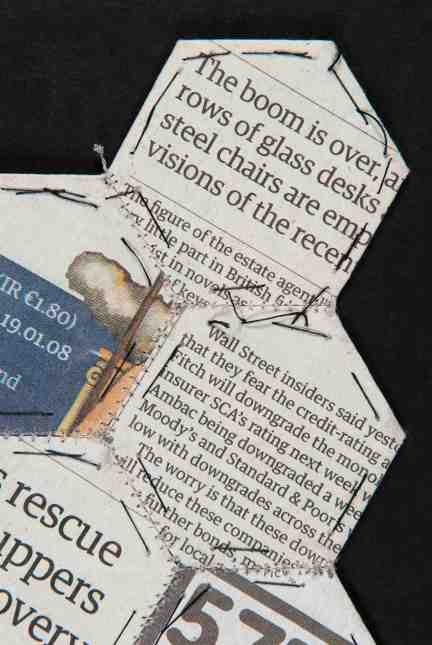
I also feel I cannot miss the opportunity to look at the work of John Baldessari, this part of the course starts with an image of his work, called, Quality Material. (Study Guide: 91) Christopher Miles in a Tate article (Miles:2008) writes about how the text paintings became artworks in Baldessari’s practice: “..why would I translate this photograph into a painting? I mean, it takes a lot of time. Why can’t I just use photography?”, he quotes Baldessari. Miles calls this a sort of epiphany by Baldessari, as it changed the direction in the way the worked, as he was now working (After his Cremation Project, 1968) as a conceptual artist: addressing ideas to remove the artist’s hand from the practice, works that consisted entirely of painted texts, or as stated descriptive terms – almost replacing imagery and going beyond the use of photography. I am understanding how we see images as coming first into our mind, before language? I became more interested when I read about him questioning ideas that words and images can be viewed as interchangeable. In this conversation with Miles, he spoke about this as the place where his interest in writing came to play. Now he would look for the right word next to the right word – building a syntax? He talked about getting attracted to details and parts of things – that feeling of happiness if just one square inch of a painting makes you happy. (Miles:2008)
I could relate to this and see something of myself here, as I do intend to look at fragments and consider how I can approach this project. I am working on a commission and am not really happy with the work, but an area in the work, made me feel that I could be ok with what I was making.
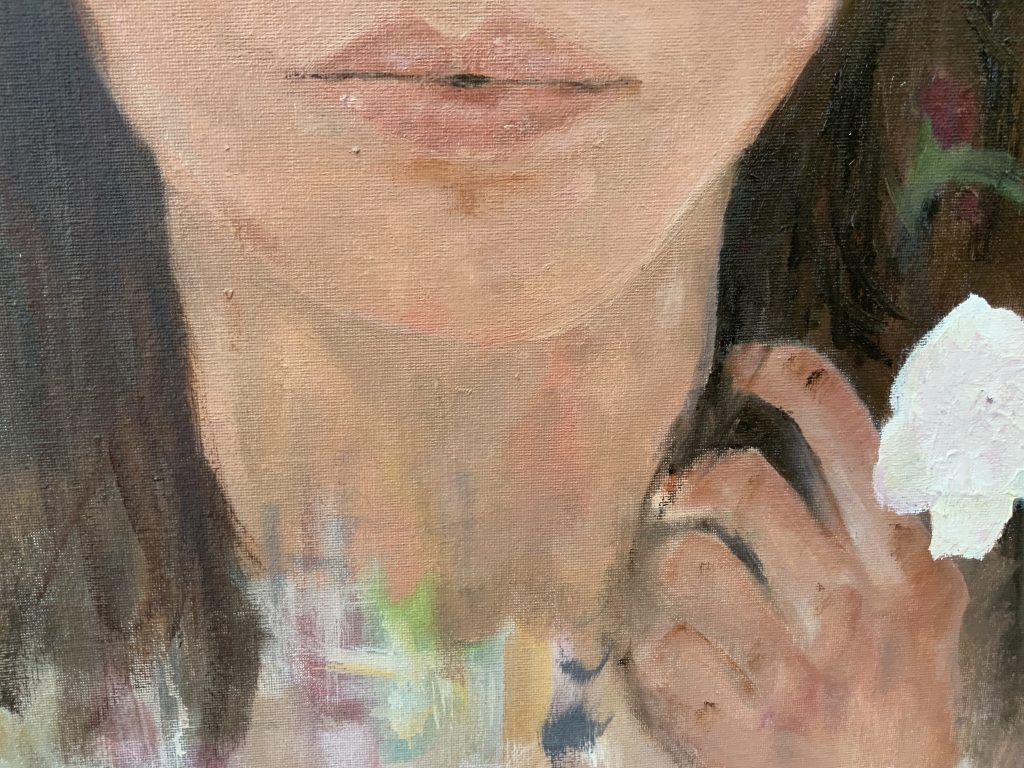
“I get really attracted to details and parts of things. I used to tell people I would feel happy if there was just one square inch of a painting I liked. I wouldn’t even have to like the whole painting.” Such a fondness for fragments, combined with a general dislike of how photography imposes formats on images and a tendency to think of words and images as interchangeable, drives his practice. “That’s where my interest in writing comes in; it’s getting the right word next to the right word that’s important… it’s syntax,” he says about the juxtapositions in his work.” (J. Baldessari, 2008:Tate)
METHOD
My thoughts at this stage: Is text not about the literal world? – thinking about artmaking that connects with this, like collage and montage, something I have not really experimented with a lot or applied my mind to as part of my creative practice. I do like poetry and yet have never worked with it in my art by using text. Words have a way to talk to me about how I receive and interpret different types of information – I can describe it, almost analyze……is this always about logic? Is it not also a place where one easily falls into a type of wormhole? Words can, like a painting, become layered with meaning, confusing, gibberish, illegible, or smudged. Imagine words in a language I cannot understand? I can visualize words in Neon, words on paper, words on glass, words on ceramics, and words on canvas, using all different kinds of materials. It seems words must become the object, the subject: ideas like words belong to everyone, words are free, words can change the meaning …must words have meaning? My inclination is to turn words around, a game we used to play with my mother, as kids, and goes something like: How lliw I tuc PU ym tra ot understand flesym ? (How will I cut up my art to understand myself). I am confronted to look at words, and myself: Is it possible to look at words as a ‘raw material’? I can ‘manipulate’ words, can change their meaning by juxtaposing it with an image/painting, and use it in a process of making art. Should I also ask: what con[text] should I follow….technology, collage, stencil size medium, repetition, colour?
Whilst trying to get to make work, I remembered an artist who works with words. He is Mel Bochner, born in 1940. I will add him to the research point.

The choice of text to consider is a paragraph in my study material, p 94 under the heading Method. I started typing random words:
words, phrases, fonts, randomly, take, order, random combinations, construct, new text, repeat several times find a stream of words that interest you, work through exercise remember to document the outcomes in your sketchbook.
New combinations made with the above words:
document the random combinations of words remember the outcomes
remember word combinations
remember to construct new fonts
words find random combinations of interest
you work to find order through random combinations
to repeat a stream of words randomly
take work several times words take work
exercise
find fonts of interest take to outcomes
find a stream
construct the outcomes
through exercise stream take order
order randomly remember(s)
order repeat streams of words
interest work through exercise
document combinations of words several times
exercise a(n) interest you find
construct a find document the outcome
you find streams
you find words
you exercise words several times
I can see the potential that they could become an instruction, a declaration, a question,
- instruction
- declaration/manifesto
- question
- translation
- poem
- humour
- disruptive
In November 2021 I attended an online art activism workshop and went back to work on paintings I had done around rhinos and poaching. I added words onto the canvas. These words were a contemplation of effective methods to control the poaching of rhino horns. I became aware that activism does not need to be confrontational, there is value in looking for understanding and compromise. For the first exercise, I contemplated fragments of words. For the first image, I used an app, Snapseed to overlay two images, one a photo of an orphaned rhino calf and the other my painting of a rhino carcass where the horn was cut off. I used words and placed a statement: A live rhino is an asset, not a horn. My thoughts were around how one can use words to educate and motivate behaviour. I can imagine this type of image as street art, or a big poster where the words can be spray-painted onto the image – As street art to make an audience listen in a different way? To understand that rhino horn can be harvested and shared with a market who have over a long period viewed it as a substance of healing. By understanding this belief and also showing support for the animal not to be killed. Can I call it sustainable conservation? I can consider translating these words into more languages, and use this image to develop bigger work with printed words or even printed words next to the image.
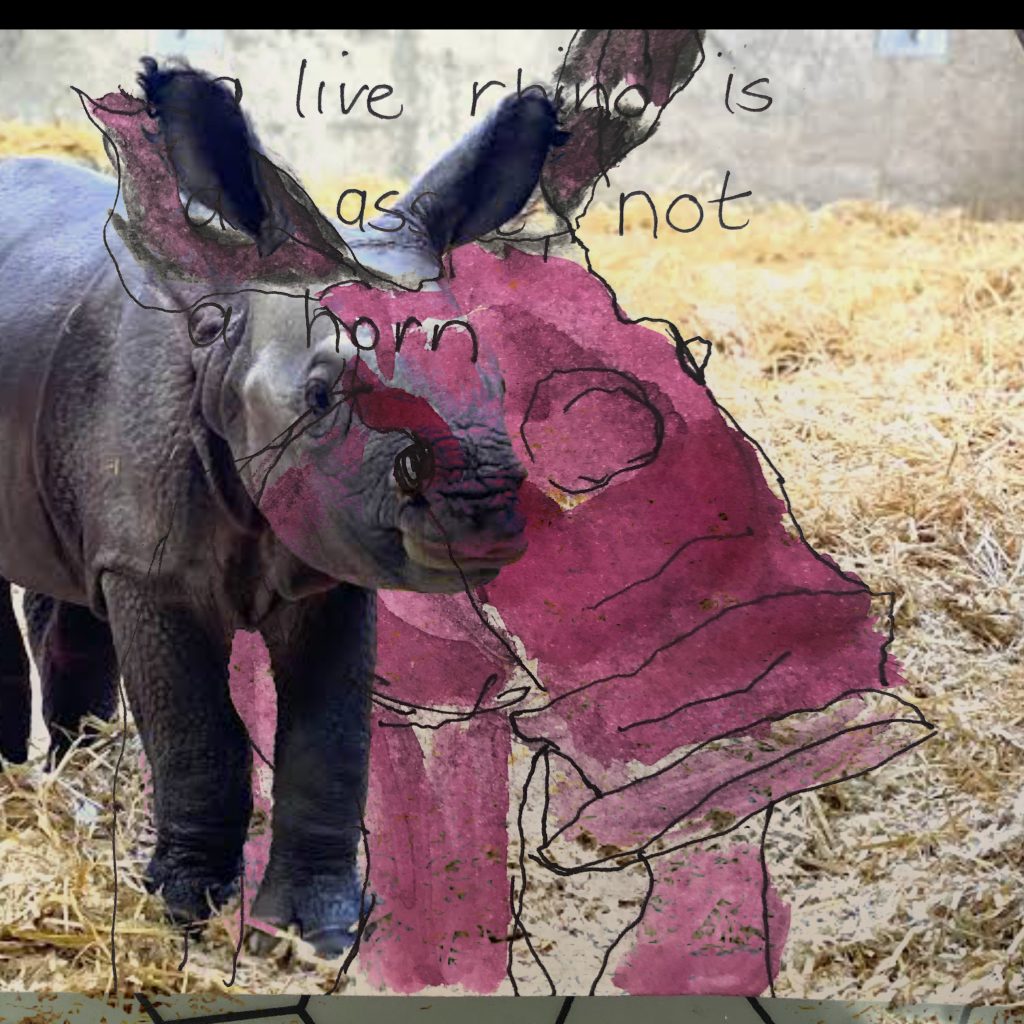
Current cases I am following: “One of the accused, Ping Wu, was convicted on two money laundering charges in the Tembisa regional court. The case was remanded to February 9, 2022, for sentencing. The racketeering trial against the other two accused, Huang and Chen, continues and was postponed to March 3 for the state to lead further evidence.” (news bulletin) I have not found any feedback on the outcome of the sentencing. (Facebook group: Stop Rhino Poaching.com) On 16th February 2022, a woman in the city of Bedfordview (Gauteng province) was arrested after 29 rhino horns, worth E6m, were allegedly found in her garage. The 29 horns were wrapped in heavy aluminium foil. She could be running a trafficking syndicate! She was supposed to appear in court on Friday 18th February 2022.
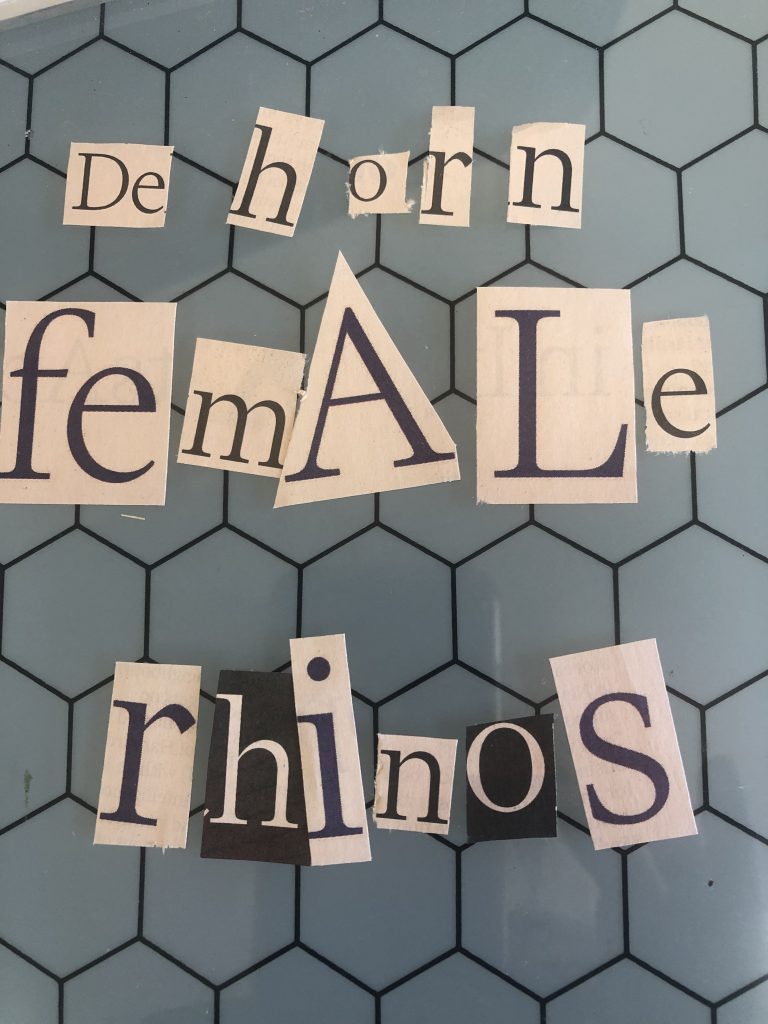
For the second painting I wrote words, then hid them with paint and started looking at fragments of the statement. The original statement asked: How effective is your anti-poaching control? De-horn the female rhinos and save their offspring. This addresses real issues around game parks and how they are seemingly reluctant to de-horn their rhinos – tourists need to see the real animal, and funding is a big issue. It seems research is showing that most of the females that die, are pregnant, and not all babies can be saved when the female is killed by poachers for her horn. If we de-horn females, we can surely save the next generation? I do wonder about their rehabilitation from an orphanage back into the wild.
I thought about conservation and how effective all the costly efforts actually are, compared to the onslaught which seems to not ever going to stop. As conservationists have started to use high-tech solutions such as AI monitoring of the rhinos as well as their areas. A combative style, where armed guards patrol areas where rhinos roam, with the use of aerial support, is also used. This combative style is not effective for areas visited by tourists, seen from the tourists’ viewpoint. With this ‘war’ being ongoing a lot of lessons have been learned, and I started asking questions about the female population and the fact that one is very aware of many females who were pregnant when killed, or where the baby survived, but now has to be removed from the natural environment and taken to an orphanage for care.
Our latest poaching figures (March 2022) show a decline of nearly 60% in the population within our biggest conservation park, the Kruger National Park. Here birthrates continue to fall and the rhino populations are seen as fragile, like poaching, drought, and habitat availability are becoming bigger threats to their survival. It is currently viewed that a rhino is killed for its horn every 22hours in Southern Africa.
My thesis then became: If the females are dehorned, will one not save the rhinos? Can the conservationist share the number of rhino killings, that are females? Can the conservationist share the numbers of rhino killings where the female was pregnant? Can the conservationists share the numbers of rhino killings where a calf was left orphaned?
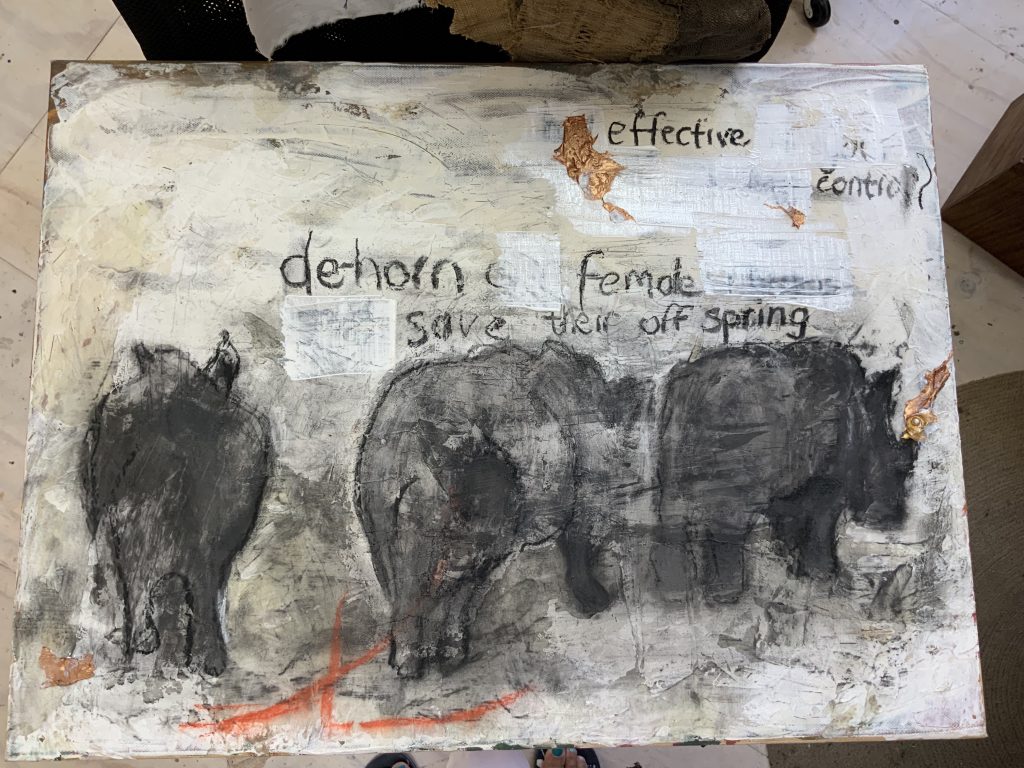
My words in this work are viewed as a sort of source text: I want to test if they can create new layers of understanding – meanings around the value of the rhino horn, the value of being a rhino, the value of the continuous existence of this species, the value of animal life, the value of motherhood, the value of protecting species that are threatened, and test art as activism. The artwork looks at layering as a form of erasure and thinking, to recall, hide and explore mark-making, as well as a way of thinking and acting with this complex subject. By placing the work as an exploration of activism on social media, using hashtags was also a way to use words in an attempt to engage with a wider audience. (personal Instagram account on 22/02/2022)
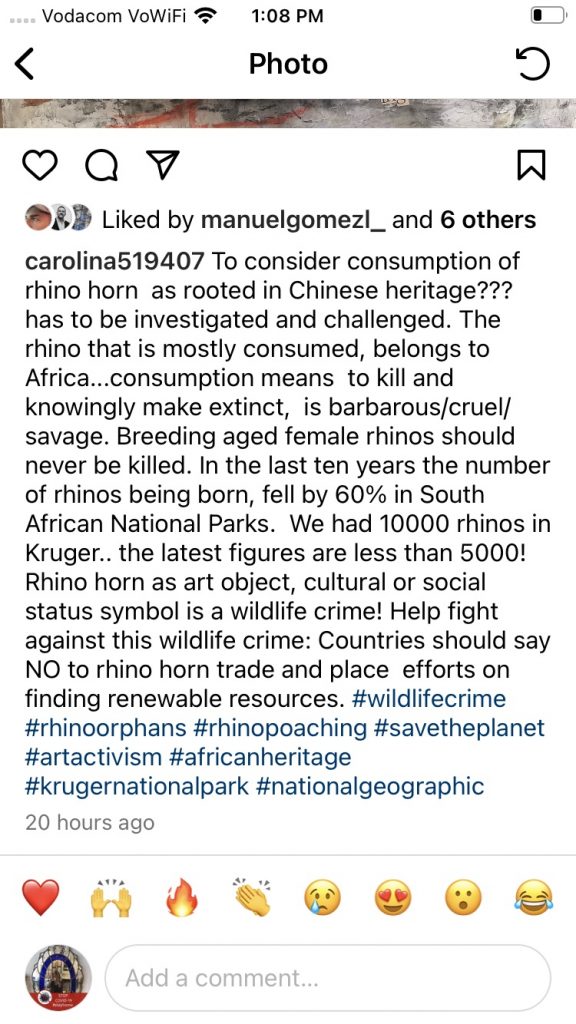
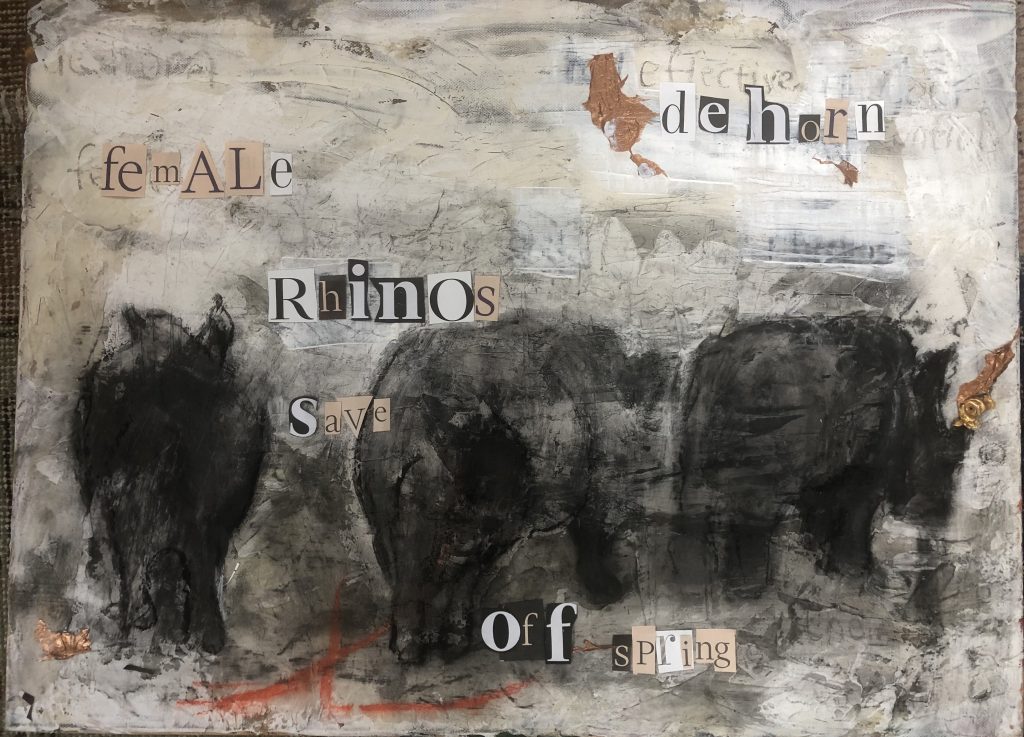
The work I share here was done on canvas and I used a photo image taken of three rhinos at a waterhole. I have used this image as a painting on copper and this is just a further exploration, where I thought I could apply the text as another layer.
I do think it is becoming clear to me that written language doesn’t require a reason or a logical syntax to reach an understanding of ideas.
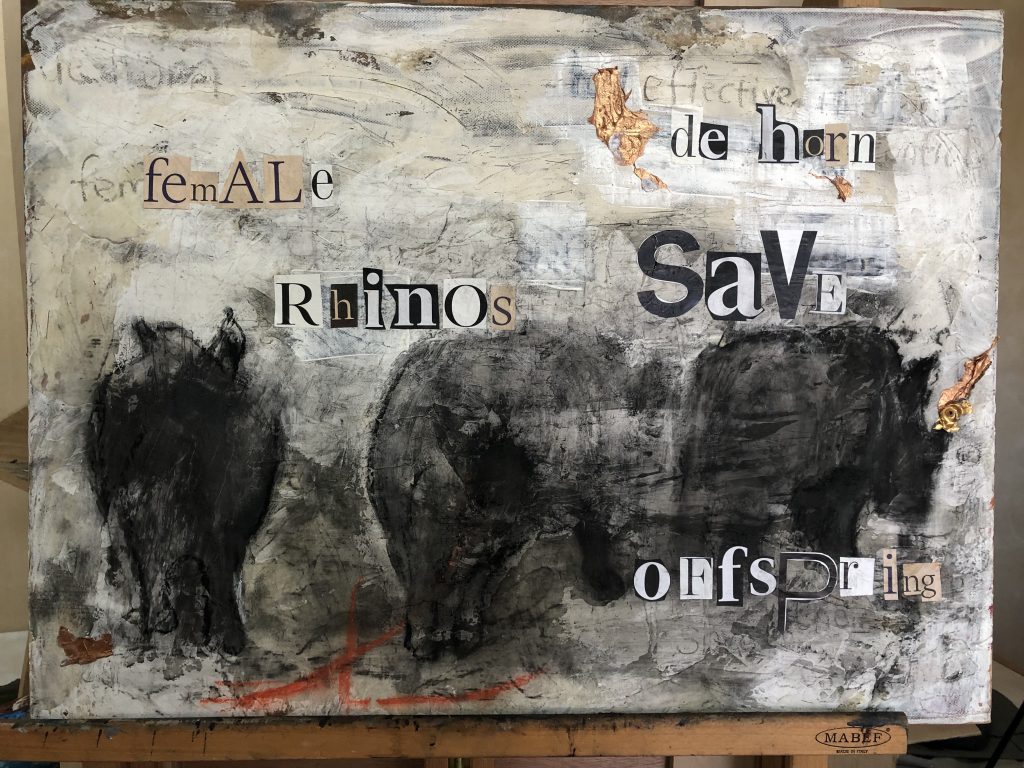
I shared the work in a silent crit session with other students, and below is a transcript of the feedback. (sound recording on my cellular phone was used during the session) I note my reaction in brackets at the end of each comment.
- This is Karen’s Rhino practice (this student knows about my blog) and a continuation of the project and now moving into text, the words Female, effective, dehorn, pulls the viewer into work, thinking about poaching issues in South Africa.
- Then the other words are viewed with the images of the rhinos – a sense of hovering, that they are disappearing. (is this saying the text works effectively with the words?)
- Images gives a sense of hovering on the edge – a waiting. (effective activisim images?)
- Powerful – the text and title, two different textural qualities at the same time (successful combining of elements here as text and images can work)
- Layers are seen in the surface of the work – colours, drawing itself and text (value of text?)
- Disturbing (is this emotion/reaction what I want to achieve?)
- Choice of colour and Red orange line – hidden, charcoal gives you something that is there, not there. It looks like blood but also keeps the rhinos grounded on the wall
- A mark the red and how it is related to when trees are cut in a forest – mark? (signals in a forest to cut down a tree, in this case, extinction? I am reminded of a community project I was involved with, where we looked at radiation due to mine activities and houses were marked which showed signs of radiation, here the people were told it has become a health risk, a warning a visual mark? )
- One can bring your own imagination into the work – the work will reward me with more snippets of text and things going on, the longer I look ( value of taking time with a work and complex issues in the work)
- Are they walking away – disappearing very sad, you see the back of it (images touch the viewer)
- Powerful and very very sad
- Use of charcoal – reminds of palimpsest and how this material is such a good record of this
- See different layers
- See a figure – is it a hunter, so tiny
- Monumental – looks like a big, they need saving
- Horn has gold – taking the horn to stop the poaching?
- is it saying something about the prize for the poacher – the gold?
- Feels old – aged artifact quality of this gold horn
- Use of letters are different in shapes and sizes – draws one in, need to get closer to read, need more time to read.
- Words that were written and erased give a sense of words used as working through emotions and thoughts. Passing thoughts, cannot access them anymore,
- But it also draws you in – feels like you need to excavate, a layer behind.
- Words can be read in more than one way: dehorn to save the offspring or dehorn so that cultures who use the horn can still continue, without killing the offspring. ( I do think this is looking at my own ‘thesis’. )
- How much does the text dominate – which takes over. (worth thinking about this)
- Image and forms are strong – they combine very well with the text.
- The surface reminds of the leathery skin of the rhino, like an aged book
- The surface makes me think it is a wall painting – a much bigger, monumental work on a wall
- How will one interpret this if you do not speak/read English (I like this, as it says the work has a limited viewer access, which I could see as something text could place upon a work. It also made me think how necessary words are)
To explore this further I want to consider connections and actions in the world around me as well as in myself. Words can become metaphors or symbols in conceptualizing ideas and even in social activism, they can act as behavioural signs. In a blog post, I read that: ” The cut-up technique shows itself as a creative vehicle to modify the codes of a reality, which is mostly moulded to linear reasoning.” (Faena Aleph)
Continuing to explore making and words I was considering fragments I have after a material exploration of bread starter dough that came off the surface of the ‘painting’. These fragments look like little landscapes to me – they are fragile and will continue to break up. I do think words have the power to do anything, I am aware of their power to destroy, deceit and on the other hand, share, connect, and love.
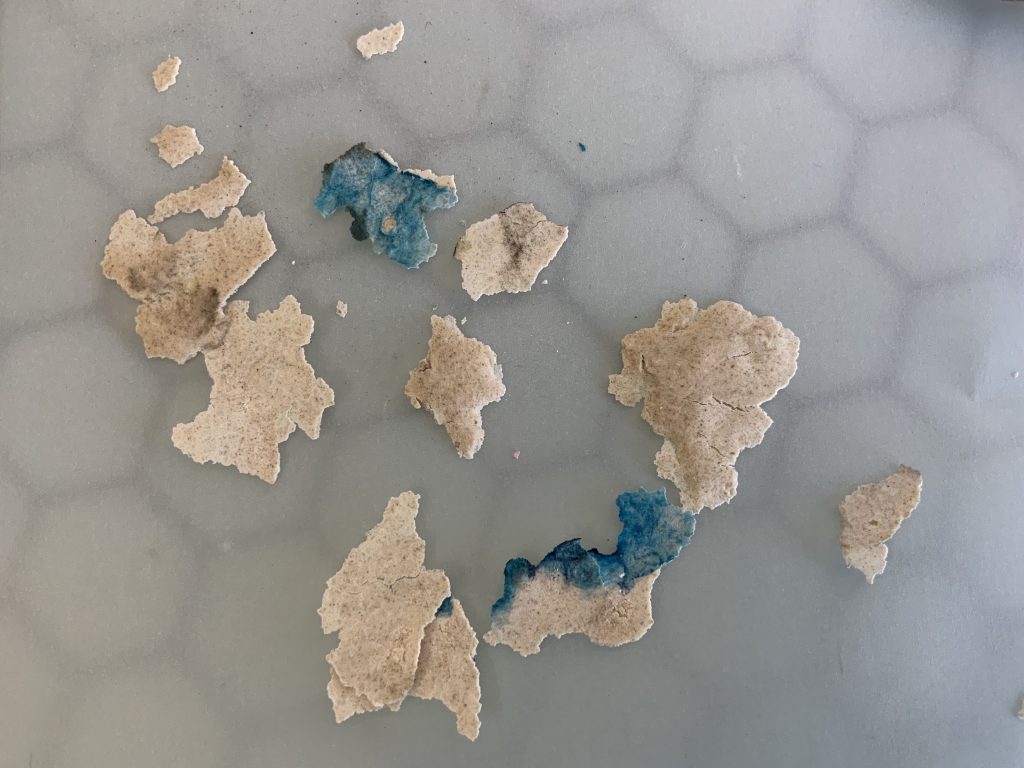

The vessel I drew and placed on a coppery background is still an ongoing investigation into objects that can also be manipulated and take on a new form/idea. I write the word, Qi with the fragments. I am looking at the Eastern Ontology of vital life energy – I do think the work I am doing on the Fungi Kingdom led me onto this path. Qi is energy in the broadest sense and is a state of continuous flux. Words like change, adjust, transform, yin and yang are contemplated. I think through materiality; I questioned my interest in nature and in what way(s) we as humans think we are part of it, or why others agree on a separation/hierarchy. I enjoy the strangeness and awe of this experience. I wonder about new meanings of language in the influence of a free flow in the making. I still construct out of these fragments.
I would think that with this work I can consider the impact of colour?
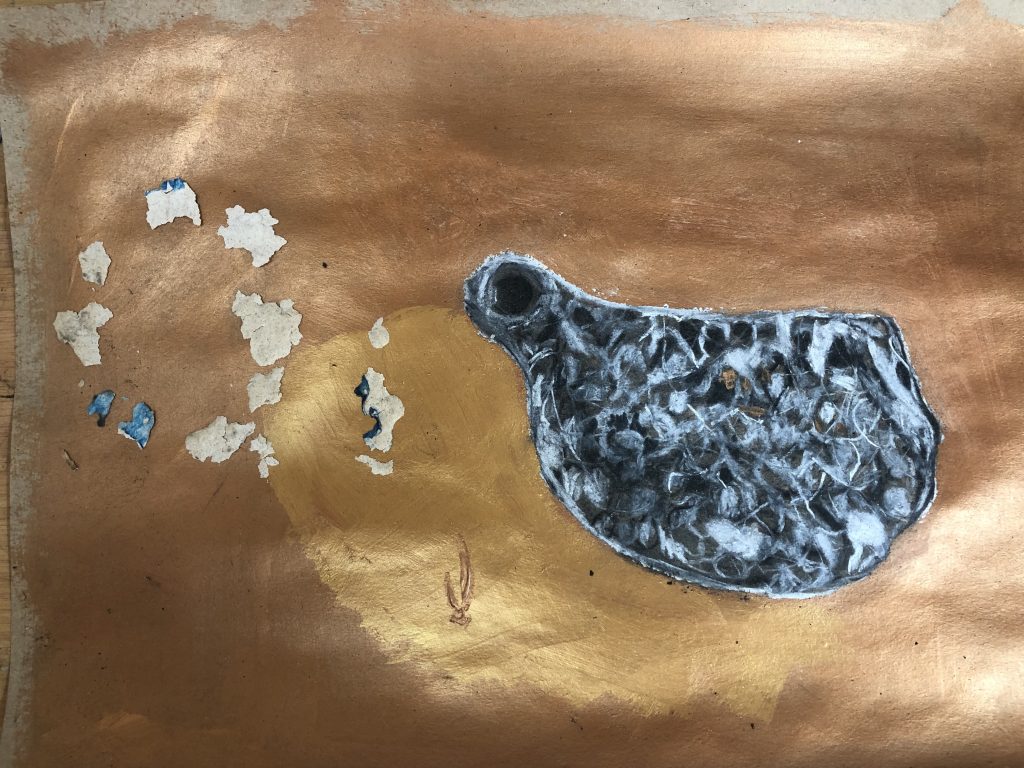
I attended an Egg Tempera session with OCA and used Indigo and Yellow Ochre and explored making gestural brush marks on a piece of plywood board, which I hastily had to gesso (during the session). Where the gesso had not yet dried became areas where I could write. The egg tempera gave the indigo pigment a lovely sheen and absorbed well onto the surface.
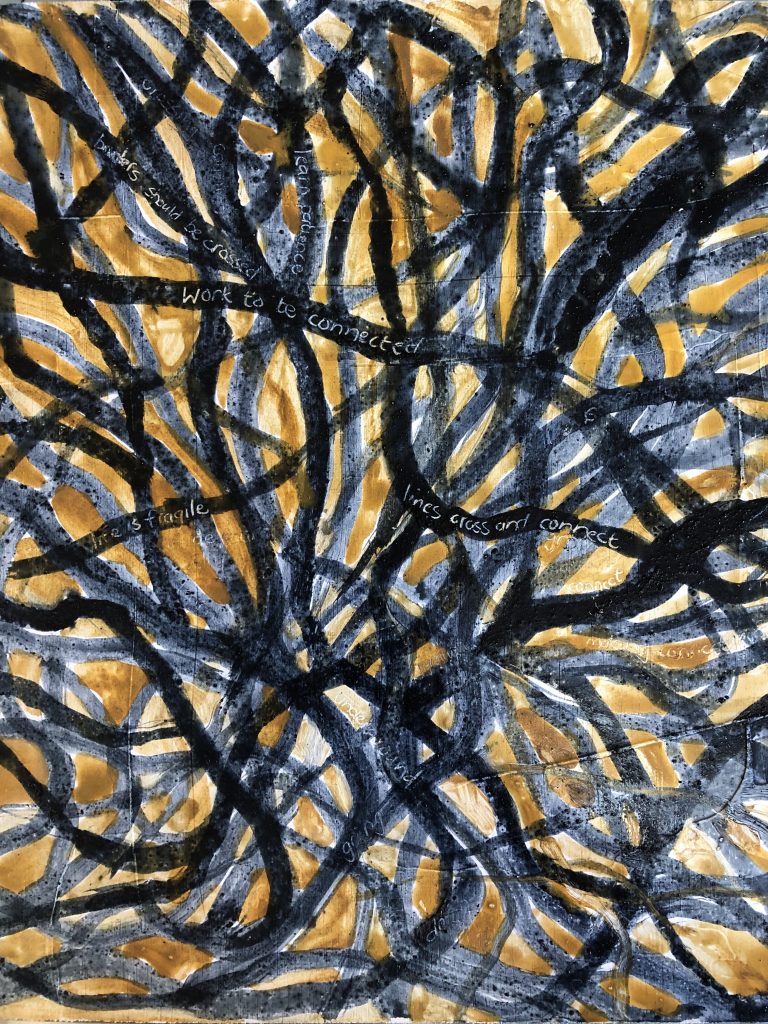
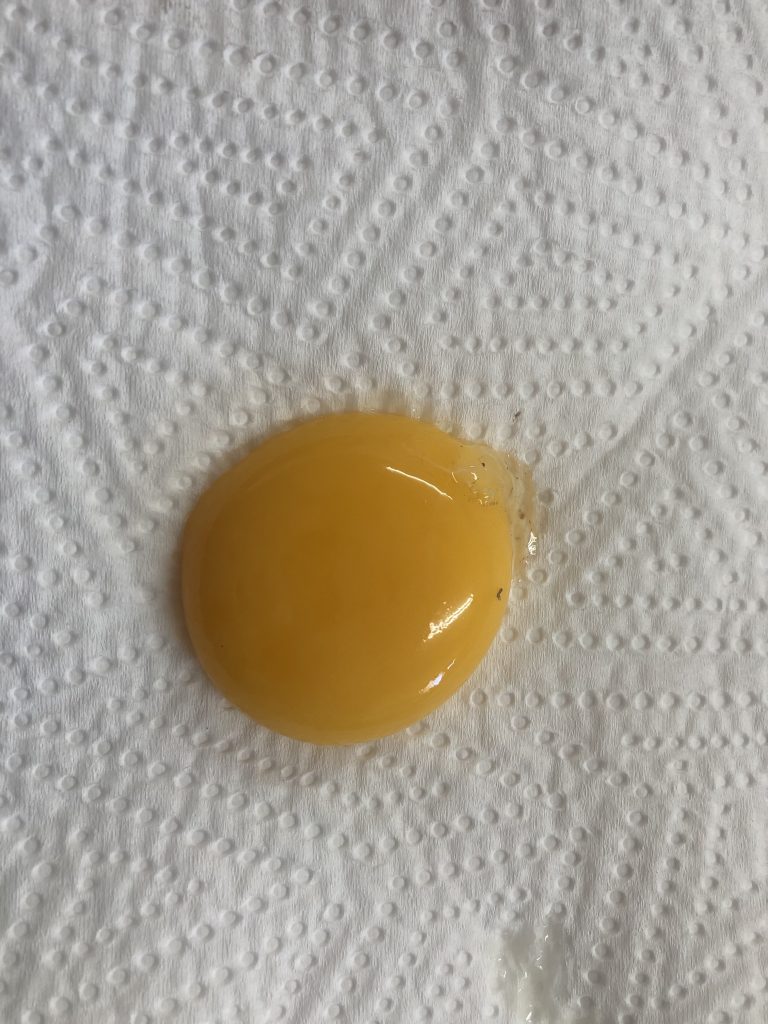
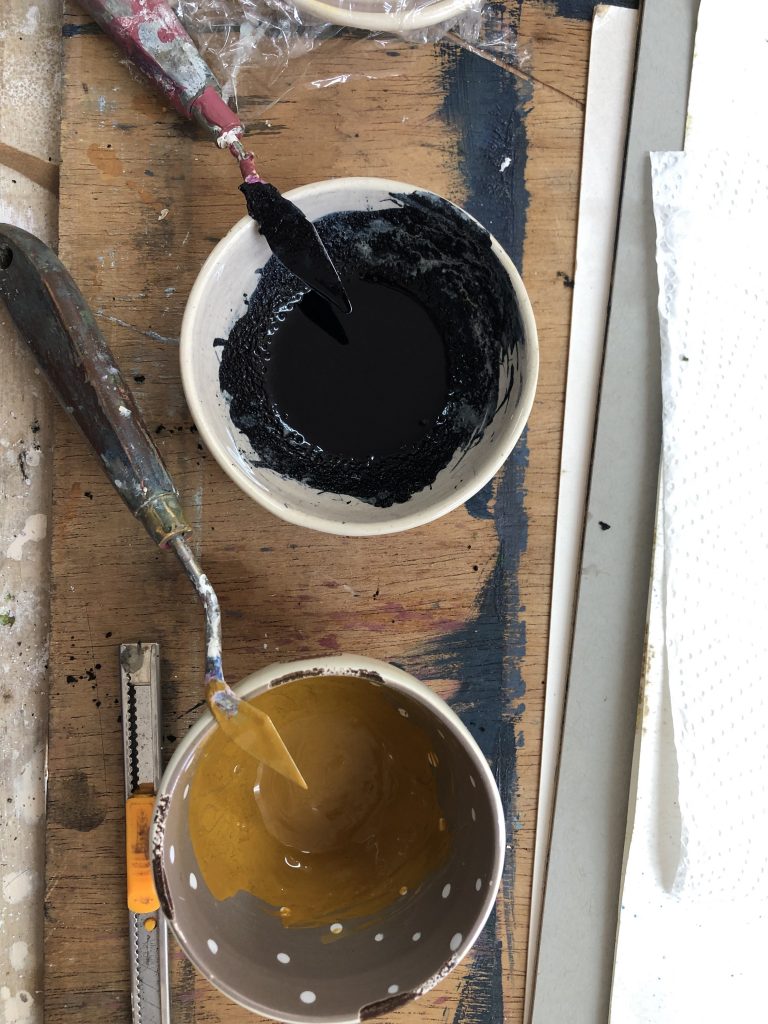

Later I wrote about entanglements, a word I have been learning about in my PP.
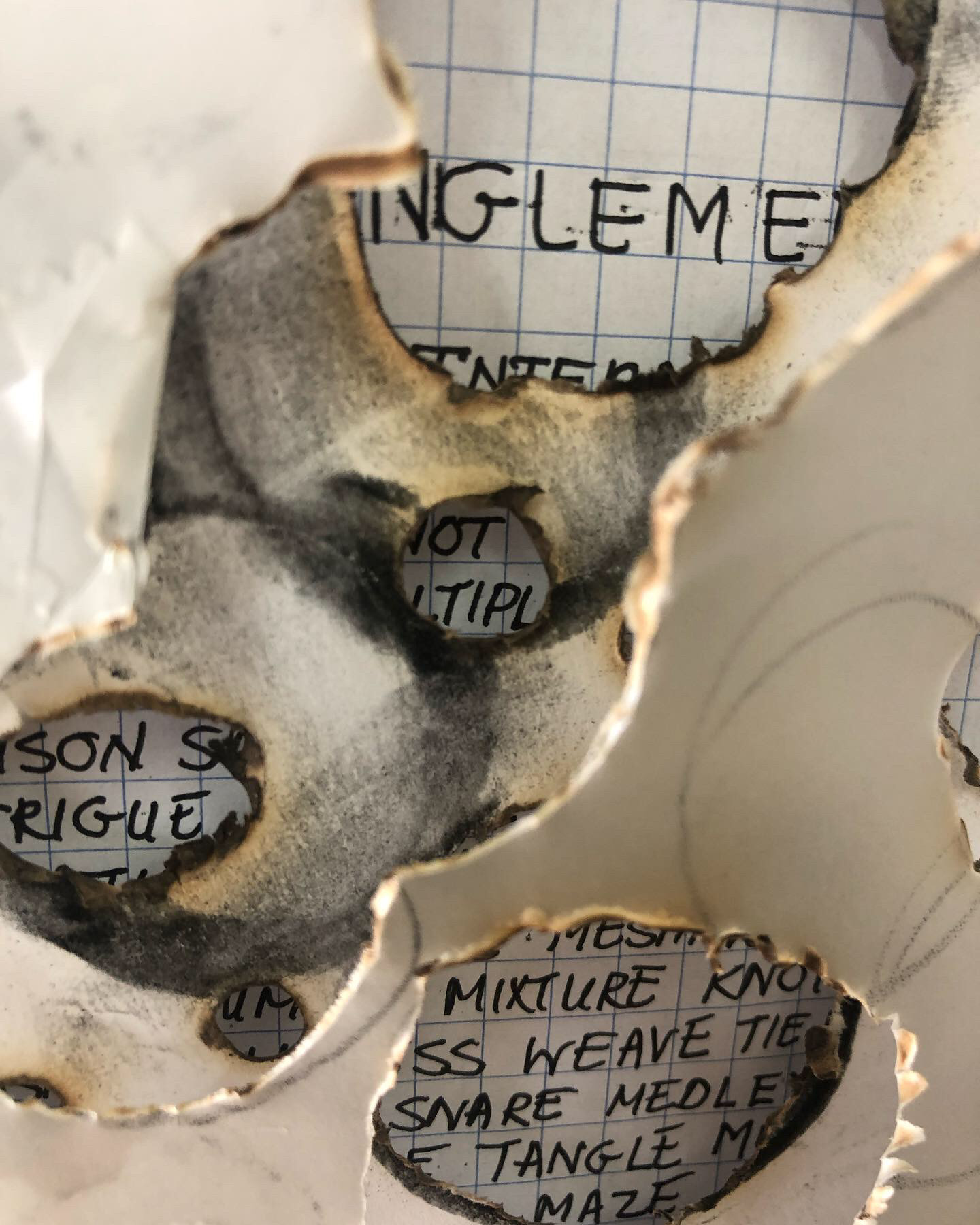

In a recent group discussion with students from OCA -EU we had a short conversation about over intellectualisation of artmaking. And a thought around words becoming a territory within the art institutions (academic, etc) how language seemingly changed – materials became deeper, materiality. We do need to criticise this, thinking about people outside the art world, when it is not relevant. We talked about being a conduit, but then we can never get away from language completely if we want to be understood. I do feel inadequate, or can I say, not fluid, in my use of English in many situations when I need to use language as a tool to explain. ( I am reminded of a workshop with dr Brian Eccleshal where our group decided to completely let language break down – almost to the point of making no sense and becoming confusion, by using different language in a recording and then trying to talk as well )
Reflecting on this making and considering developing these text works further
My learning around the use of text took me to make and explore text as a visual tool. I would like to see words in my making as a form of handwriting, which is very much like drawing and thinking. I think the engagement with materials became part of the thinking when using and thinking about the text in a visual way. Writing text is a form of embodiment I would argue.
I looked at the work of Sarah Impey who is a textile artist as well as a trained journalist. (Link 40)
During a group session with OCA tutor, Bryan Eccleshall, he showed images of the Talmud and these visual images made me think about how I would like to use text in a creative way. The traditional Jewish text in the Talmud is presented in interesting use of text fonts, colour and layout, which reminds us of an infinite expansion of the text. Looking at the Talmud one could say it is an authoritative book, but I see possibilities of how one could in a visual way apply this as an artwork, as a response to text as literature. Dr Eccleshall referred to “blurring the boundaries between statements that accompany work and the ‘work’ itself” in his reply to my own ideas around text and using it as a way to present my Parallel Project. He suggested I look at OCA tutor, Rachel Smith, who has in her PhD responded to text in a visual way. I created a separate blog post where I contemplate more on developing work. ( See blog post called: )
I later discovered the work of Jacqueline Nicholls in a Google search. This artist, from a Jewish background, shared a blog over time (7 years, ending January 2020) about her reading the Talmud daily. She did this by making art accompanying her work., which she limited the time of making to 30 minutes a day. This work is called Draw Yomi. It was done reading and then reacting with a drawing, a page a day. The work is in a way illustrative and figurative, but becomes abstract as it is also sharing thinking and learning during the process of reading text, and reacting artistically to it. The work became an engagement with reading the Talmud; and looking at this process, I found it interesting that her reflections as words and art is also her own reaction to the text, and that of a female perspective. (blog:http://drawyomi.blogspot.com/)
List of Illustrations
Fig. 1 Impey, S. (2013) Social and Political Issues [newspaper quilt stitching] At: https://criticalcloth.wordpress.com/2015/04/05/sara-impey-text-in-textile-art/ (Accessed on 14/02/2022)
Fig. 2 Stander, K. (2022) Boho Girl work in progress [oil on canvas board] In possession of: the author, Langvlei, Riebeeck West.
Fig. 3 Stander, K. (2022) Fragment I feel happy with [oil on canvas board] In possession of: the author, Langvlei, Riebeeck West.
Fig. 4 Burroughs W. (1983)
Fig. 5 Stander, K. (2021) Activism in words – explorations [photographic and painting overlay with App] In possession of: the author: Langvlei, Riebeeck West.
Fig. 6 Stander, K. (2022) Using words [image of work in progress] In possession of: the author, Langvlei, Riebeeck West.
Fig. 7 Stander. K (2022) Work in progress [painting with text] In possession of: the author, Langvlei, Riebeeck West.
Fig. 8 Instagram post (2022) Comments on work with text [screenshot taken] In possession of: the author, Langvlei, Riebeeck West.
Fig. 9 Stander, K. (2022) Work in progress [Painting with text] In possession of: the author, Langvlei, Riebeeck West.
Fig. 10 Stander, K. (2022) Will they listen. [Painting with text collage] In possession of: the author, Langvlei, Riebeeck West.
Fig. 11 Stander, K. (2022) WIP [dried doug as words] In possession of: the author, Langlvei: Riebeeck West.
Fig. 12 Stander, K. (2022) untitled [dough, acrylic paint on canvas paper] In possession of: the author: Langvlei, Riebeeck West.
Fig. 13. Stander, K. (2022) Mycelium networks [egg tempura with indigo pigment] In possession of: the author: Langvlei, Riebeeck West.
Bibliography
Miles, Christopher. (2008) Nine to five [online article] Available at: https://www.tate.org.uk/tate-etc/issue-13-summer-2008/nine-five (Accessed on 17 February 2022)
Aleph, F. Cut UP: The creative technique used by Burroughs, Dylan, Bowie, Coban. [Editorial Blogpost] At: https://www.faena.com › aleph › cut-up-the-creative-tec… (Accessed on 20 February 2022)
Nicholss. KJacqueline, You Tube. Learn Talmud like an Artist, Jewish Strudies-Fordham 03/02/2021